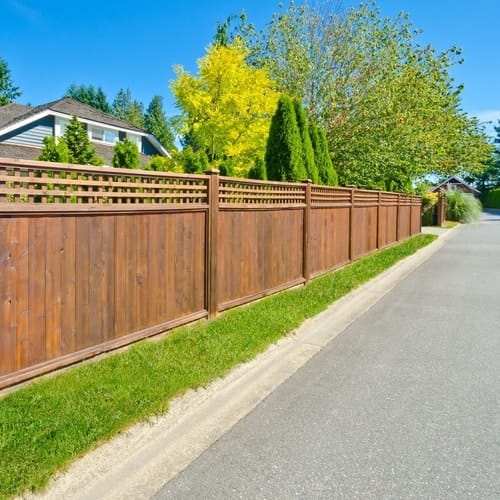Fence Staining: Boost the Charm and Long Life of Your Fence!
Wiki Article
How to Pick the Right Fence Discoloration for Your Residential Or Commercial Property
When it comes to boosting the appearance and durability of your building's fencing, choosing the best tarnish is an essential decision that requires cautious factor to consider. Just how can you make certain that you select the excellent fencing tarnish that lines up with your residential property's style and upkeep needs?Comprehending Wood Types
To select the appropriate fence discolor, it is necessary to have a thorough understanding of the different kinds of timber frequently utilized for secure fencing. When picking a fencing tarnish, it is vital to consider the type of wood being made use of to make certain compatibility and optimal protection. Understanding the characteristics of various wood kinds will certainly aid you make a notified choice when it comes to choosing the right fencing tarnish for your property.Selecting the Right Color
Selecting an appropriate hue for your fencing tarnish is a crucial choice that dramatically impacts the overall visual allure of your building. The color you select ought to match the style of your home, blend harmoniously with the environments, and show your personal taste. When deciding on a shade, consider the existing color scheme of your building. For a natural appearance, earthy tones like browns, greens, or grays function well. These shades can assist the fence mix into the landscape and develop a natural appearance. If you prefer an even more modern or strong look, consider going with darker shades like black or deep charcoal for a striking comparison. Lighter shades such as whites or light grays can make a fence show up larger and include a touch of elegance to your property. Eventually, the appropriate shade selection will certainly boost the charm of your fencing and elevate the total visual allure of your home.
Considering Transparency Degrees
When choosing the ideal shade for your fence discolor, an additional vital aspect to think about is the degree of transparency that will certainly best fit your residential property's visual and maintenance requirements. Openness degrees in fencing discolorations usually fall into three groups: transparent, semi-transparent, and strong. Take into consideration the level of exposure your fencing faces, the desired maintenance frequency, and the visual you wish to accomplish when choosing the ideal transparency degree for your fence stain.Evaluating Upkeep Demands
Considering the longevity and upkeep of your fence, evaluating the maintenance demands is vital in identifying one of the most appropriate fencing stain for your building. The level of upkeep needed for your fencing can differ depending on aspects such as the kind of timber, weather in your location, and your personal preferences.When evaluating maintenance demands, it is vital to take into consideration the durability of the fencing tarnish. Some discolorations need more regular reapplication than others, so selecting a discolor with a longer lifespan can aid minimize the general maintenance needs of your fencing (Fence Staining). Furthermore, factors such as resistance to UV rays, water, and mold can influence exactly how often you need to re-stain your fencing

Testing Samples Before Application
Prior to applying any fencing discolor, it is recommended to carry out sample examinations to guarantee compatibility with the timber and wanted visual result. Evaluating examples enables you to evaluate how the tarnish will interact with the details kind of timber used in your fencing, as different woods can absorb discolorations in a different way. To begin, choose a little unnoticeable location of the fence to use the stain samples.Conclusion
Finally, choosing the ideal fence stain for your building involves comprehending the timber type, selecting the right color, thinking about openness levels, assessing upkeep needs, and testing samples before application (Fence Staining Service). By taking these elements right into factor to consider, you can ensure that your fencing stain matches your residential property while supplying the necessary security and sturdiness. Make a notified choice to enhance the look and long life of your fencingReport this wiki page